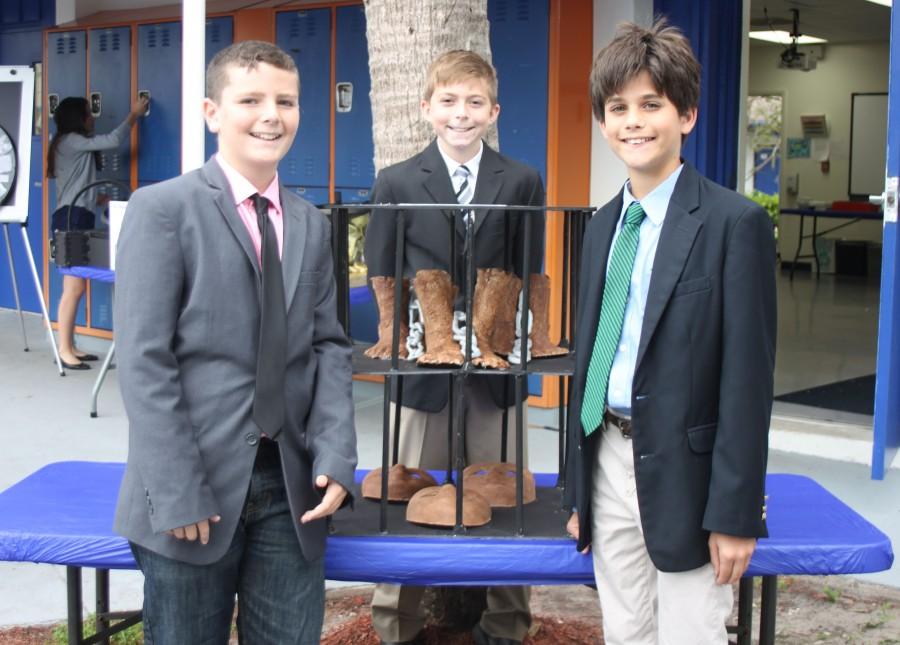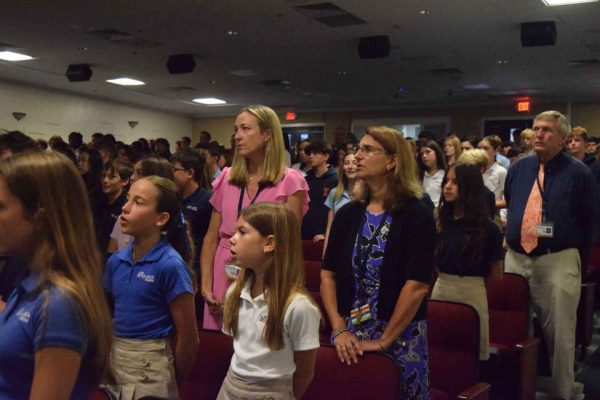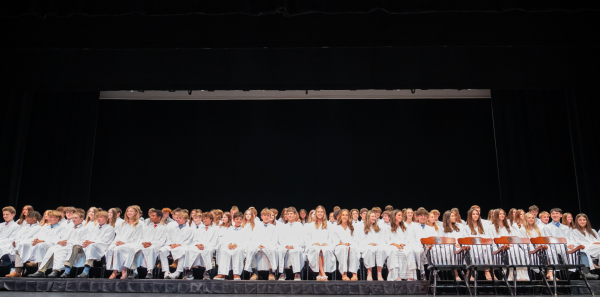Students Combine Food and Art During Heritage Day
Left to right: Sixth graders Zachary Loceff, Casey Crawford, and Jake Zur pose with their Heritage Day project which they created with the help of artists from the Center for Creative Education. Their project includes molds of faces and chained feet, meant to represent the slaves that were brought over to the colonies from Africa.
“I truly think that you can’t know yourself if you don’t know your family, and that is why it is so important that we have Heritage Day,” explained Head of Middle School Mr. Charles Hagy. Heritage Day, which is organized every year by sixth-grade English teacher Mrs. Denise Ponchock and sixth-grade history teacher Mrs. Pamela Quigley, is the annual culmination of the sixth graders “Coming to America” unit in which they learn about their ancestors emigration to the United States. Heritage Day took place on Tuesday, November 22 this year, and the sixth graders invited their family members and special friends to share various ethnic dishes, see the journals they created in English class, and watch the songs, dances, and performances which pertained to their ancestors’ heritage or countries of origin.
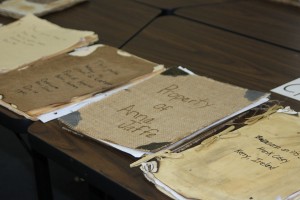
The students’ journals were on display for friends and relatives to peruse.
This year, the students not only researched their families and created journals from the perspectives of their ancestors, but they also worked on a history project based on the 13 colonies with the Center of Creative Education. This is the second year that the Benjamin Middle School has worked with the CCE, and this partnership has enriched the curricula and allowed the students to understand more about what they study in class. For example, in history class, sixth grader Grace Kearns helped make a cornucopia with classmates for her art project, which helped her learn about the pilgrims and the first Thanksgiving.
Mr. Hagy explained to The Neersyde how the Middle School came to partner with the CCE so that students could have art integrated into their Humanities curriculum. Such a feat is impossible to accomplish without outside assistance as the middle school art department cannot, schedule-wise, be in enough history classes to accomplish such a project. “We started working with Center of Creative Education experimentally,” said Hagy. “We wanted the students to be making art of scale in classroom with artists who could support Ms. Nancy McAllister, the middle school art teacher. We wanted it to be [a study of their] ancestor[s] combined with creative art. This day teaches the students about the American Dream which is still going on today.”
Ponchock oversees the journal writing and feels the Heritage Day experience is essential for her students.
“Heritage Day and the Coming to America project are important from a history standpoint because they allow students to delve into the traditions, history, and customs of their country of origin,” said Ponchock. One cannot read Ellis Island or The New Colossus without an understanding of the historical events that reside just below the surface of [those] poems. In working on the CCE projects, students acquired a deeper understanding of why their ancestors immigrated. In writing their Coming to America journals, students developed awareness of historical events and their ramifications.”
The students also enjoyed this day because it allowed them to learn about their ancestry while celebrating their heritage with family, friends, and food.
“I brought in a dish called Cream Kadayif,” said sixth grader Joey Palomba. “It is basically strips of dough with cream inside.
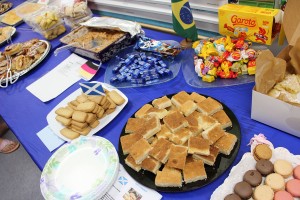
The dessert table in Mrs. Quigley’s room was filled with decadent dishes.
My ancestors are from Armenia, so I did research about my family in Armenia, and I learned that there was an Armenian Genocide [carried out] by the Turks. Back then, my great grandfather’s dad was already in America making money, so my great grandfather and his two brothers headed to America, but everyone except my great grandfather got killed by the Turks.”
The students made Coming to America journals based on their ancestors. They answered certain questions and either typed or the content or wrote it in old-fashioned hand writing. They had to make the journal look old, so some students burned the edges or used special paper with binding and leather instead of stapling.
This year, the students not only researched their families and created journals from the perspective of their ancestors, but they had the opportunity to make art projects in history class with the Center of Creative Education. The students each were assigned a certain topic to explore on the subject of colonial life. Then, with the help of the CCE artists, they made dioramas out of clay depicting various aspects of the colonial experience. The dioramas were set up on tables in the sixth-grade area, and the sixth graders were in professional dress ready to explain their projects to the seventh and eighth graders as well as their parents. The other students were really able to learn about the sixth-grade studies because the sixth graders were very forthcoming in explaining them.
“I really enjoyed making the art projects,”sixth grader Sadie Burns explained. “I did a project on indentured servants, and I learned a lot.”
The students were very proud of the journals they made, and they all learned a lot about their own heritage. The seventh and eighth graders will also be working with the CCE this year in their history classes. The Neersyde can’t wait to see what they produce as well.
